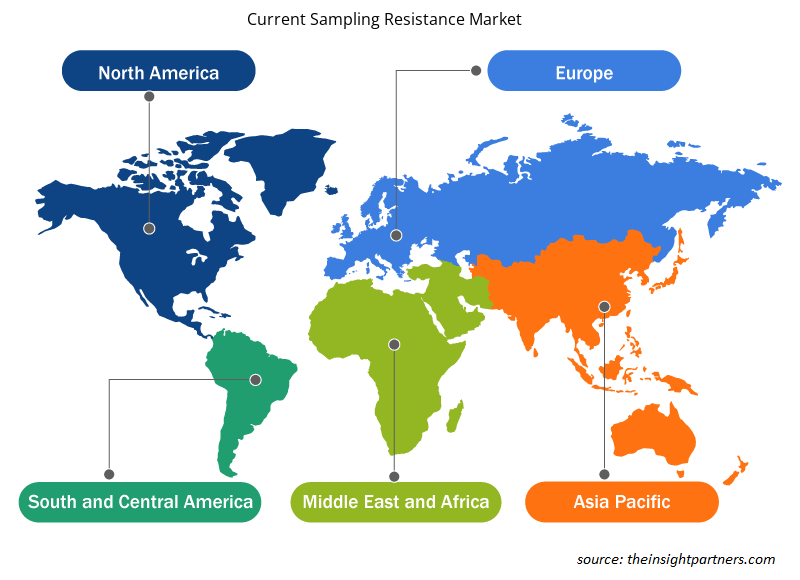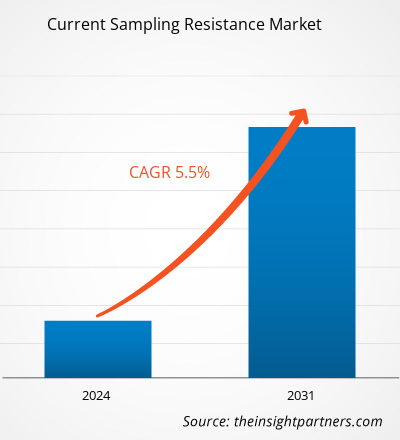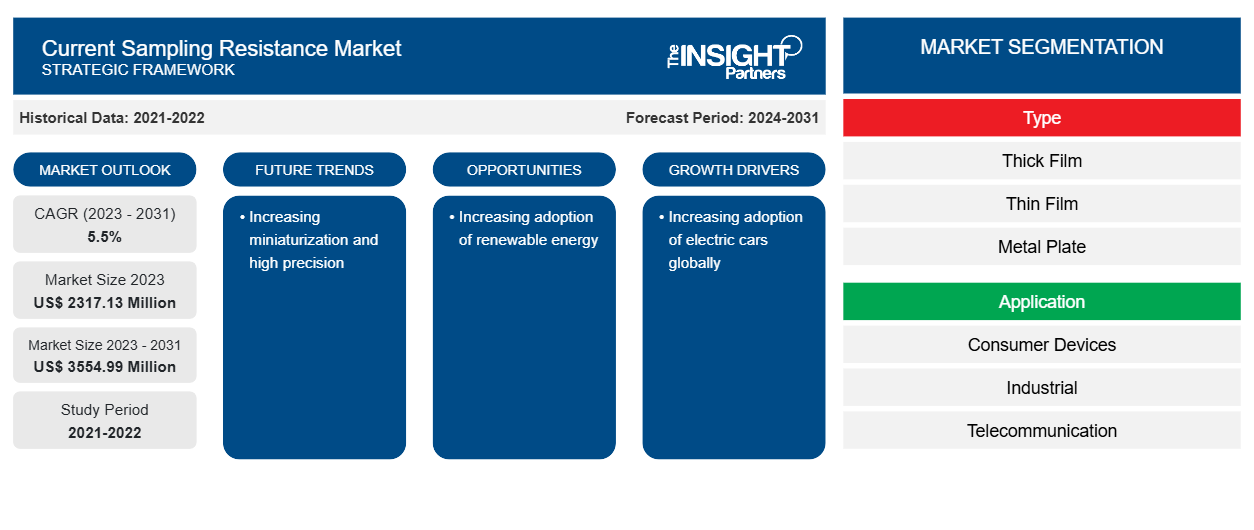当前采样电阻市场规模预计将从 2023 年的 23.1713 亿美元增至 2031 年的 35.5499 亿美元。预计 2023-2031 年市场复合年增长率为 5.5%。小型化和高精度化可能仍是市场的主要趋势。
当前采样电阻市场分析
随着在较小面积上实现更高性能的做法变得越来越重要,高密度贴装电阻器在多种应用中的使用有望提高速度。01005 英寸(0.0160.08 英寸)尺寸的电阻器正在智能手机和可穿戴设备中使用。提供细间距贴装的无圆角贴装和在元件焊盘上打孔以消除表层图案的焊盘内通孔贴装已在多种应用中提高了贴装密度。因此,各公司正在制造高密度贴装电阻器以满足需求。
当前采样电阻市场概况
材料的电流采样电阻是材料对电流或电荷通过材料造成的阻碍。电阻越高,通过材料的电流量越少。它是材料的一种特性,可以告诉我们电流通过材料的流动情况。容易传导电流的物质称为导体,它们的电阻非常低;相反,不容易传导电流的物质称为绝缘体,它们的电阻非常高。
定制此报告以满足您的需求
您可以免费定制任何报告,包括本报告的部分内容、国家级分析、Excel 数据包,以及为初创企业和大学提供优惠和折扣
-
获取此报告的关键市场趋势。这个免费样品将包括数据分析,从市场趋势到估计和预测。
当前采样电阻市场驱动因素和机遇
全球范围内电动汽车的普及率不断提高
随着电动汽车的普及,随着各种参与者推出电动汽车,市场也在增长。例如,电阻是材料对电流或电荷通过材料时产生的阻碍。此外,美国电动汽车组装量约为 230 万辆,而美国以外的组装量为 1800 万辆。根据同一份报告,到 2025 年,电动汽车将占全球轻型电动汽车产量的约 10%。因此,全球电动汽车的普及率不断提高,推动了当前的采样电阻市场。
增加可再生能源的采用
预计智能电网和可再生能源投资的增加将为开关设备市场带来诸多机遇。在智能电网运行中,自动化开关设备操作优于传统操作。自动化变电站的所有操作都是自动化的,效率更高,需要的人力更少。此外,各经济体的政府都在投资智能电网技术。例如,2022 年,日本宣布了一项 1550 亿美元的融资计划,以刺激对智能电网的投资。同年,在印度,政府建立了一项 380 亿美元的计划,以帮助配电公司改善配电基础设施。因此,可再生能源的日益普及为市场创造了更多机会。
电流采样电阻市场报告细分分析
有助于得出当前采样电阻市场分析的关键部分是类型和应用。
- 根据类型,当前采样电阻市场分为厚膜、薄膜和金属板。定制部分在2023年占据了更大的市场份额。
- 根据安装方式,市场分为表面安装、悬挂式和嵌入式/侧壁安装。表面安装部分在 2023 年占据了更大的市场份额。
- 根据类型,市场分为 LED 照明、白炽灯照明、荧光灯照明和其他照明。
- 根据应用,市场分为消费设备、工业、电信、汽车和其他应用。
当前采样电阻市场份额按地区分析
当前采样电阻市场报告的地理范围主要分为五个区域:北美、亚太、欧洲、中东和非洲、南美和中美。
亚太地区在电流采样电阻市场中占据主导地位。该地区的电流采样电阻市场正在增长,原因多种多样,例如政府为改善电动汽车状况而采取的举措越来越多,以及知名企业的存在。各种制造商都提供具有极低寄生电感和高精度电流感应的金属板芯片低阻电阻器。此外,电阻减小已接近极限,未来模块化可能会扩展到各种设备。
当前采样电阻市场区域洞察
Insight Partners 的分析师已详细解释了预测期内影响电流采样电阻市场的区域趋势和因素。本节还讨论了北美、欧洲、亚太地区、中东和非洲以及南美和中美洲的电流采样电阻市场细分和地理位置。

- 获取当前采样电阻市场的区域特定数据
当前采样电阻市场报告范围
| 报告属性 | 细节 |
|---|---|
| 2023 年的市场规模 | 23.1713亿美元 |
| 2031 年市场规模 | 35.5499亿美元 |
| 全球复合年增长率(2023 - 2031) | 5.5% |
| 史料 | 2021-2022 |
| 预测期 | 2024-2031 |
| 涵盖的领域 |
按类型
|
| 覆盖地区和国家 |
北美
|
| 市场领导者和主要公司简介 |
|
当前采样电阻市场参与者密度:了解其对业务动态的影响
当前采样电阻市场正在快速增长,这得益于最终用户需求的不断增长,这些需求源于消费者偏好的不断变化、技术进步以及对产品优势的认识不断提高等因素。随着需求的增加,企业正在扩大其产品范围,进行创新以满足消费者的需求,并利用新兴趋势,从而进一步推动市场增长。
市场参与者密度是指在特定市场或行业内运营的企业或公司的分布情况。它表明在给定市场空间中,相对于其规模或总市场价值,有多少竞争对手(市场参与者)存在。
在当前采样电阻市场运营的主要公司有:
- 鑫泰科技有限公司
- KOA 斯皮尔电子公司
- 松下公司
- 罗姆株式会社
- 三星电机株式会社
- 进株式会社
免责声明:上面列出的公司没有按照任何特定顺序排列。

- 获取当前采样电阻市场顶级关键参与者的概述
当前采样电阻市场新闻和最新发展
当前采样电阻市场通过收集一手和二手研究后的定性和定量数据进行评估,其中包括重要的公司出版物、协会数据和数据库。以下列出了当前采样电阻市场的一些发展情况:
- TT Electronics 是一家全球性能关键型应用电子元件制造商,该公司推出了金属箔芯片 (MFC) 电阻器。MFC 系列采用陶瓷上的金属箔技术,该技术利用了陶瓷基板的散热特性和块状金属合金电阻元件的浪涌耐受性。(来源:TT Electronics,新闻稿,2020 年 11 月)
- ROHM 宣布推出分流电阻器 GMR50 系列,该系列采用紧凑型 5.0 mm 2.5 mm(2010 型封装),可提供业界领先的 4 W 额定功率(电极温度 TK = 90°C)。它适用于汽车系统和工业设备中使用的电机和电源电路中的电流检测。(来源:ROHM,新闻稿,2020 年 2 月)
当前采样电阻市场报告范围和交付成果
“当前采样电阻市场规模和预测(2021-2031)”报告对以下领域进行了详细的市场分析:
- 当前采样电阻市场规模以及范围涵盖的所有关键细分市场的全球、区域和国家层面的预测
- 当前采样电阻市场趋势以及市场动态,如驱动因素、限制因素和关键机遇
- 详细的 PEST/波特五力分析和 SWOT 分析
- 电流采样电阻市场分析涵盖关键市场趋势、全球和区域框架、主要参与者、法规和最新市场发展
- 行业格局和竞争分析,涵盖市场集中度、热点图分析、知名参与者以及当前采样电阻市场的最新发展
- 详细的公司简介
- 历史分析(2 年)、基准年、预测(7 年)及复合年增长率
- PEST和SWOT分析
- 市场规模、价值/数量 - 全球、区域、国家
- 行业和竞争格局
- Excel 数据集
近期报告
客户评价
购买理由
- 明智的决策
- 了解市场动态
- 竞争分析
- 客户洞察
- 市场预测
- 风险规避
- 战略规划
- 投资论证
- 识别新兴市场
- 优化营销策略
- 提升运营效率
- 顺应监管趋势























 获取免费样品 - 当前采样电阻市场
获取免费样品 - 当前采样电阻市场